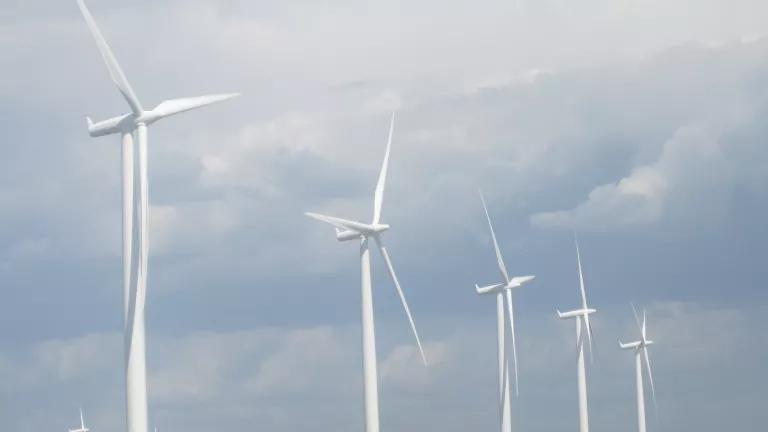Solving Problems—Not Pointing Fingers—in Texas
Blaming any one power source is a mistake. We can’t make any one source of power foolproof, but we can make a grid that’s nimble, resilient, and reliable.

A sizzling summer in Texas is demonstrating some key realities about that state’s electricity grid.
With solar power filling up a record share of power generation while some thermal power plants that burn coal or natural gas are struggling to keep running in the heat, it is clear that the tired narrative of trying to point fingers at renewable energy must finally be put out to pasture.
What we have learned in storm after storm is that no one power source is perfect. Coal piles freeze, gas lines stop flowing, and nuclear plants need to shut down before a storm surge hits. We’re now seeing that when the heat rises, fossil generation has issues too: As predicted by a regulators’ report, some coal generators are having problems. And, yes, the sun doesn’t shine at night and the wind doesn’t always blow.
But what this means is that blaming any single power source is a mistake. Instead, what Texas needs is to invest in solar and wind, along with upgrades in storage and transmission grids, and programs that reward energy efficiency and demand response. These are the cost-effective strategies guaranteed to make the power grid better able to handle the extreme weather caused by climate change. We can’t make any one source of power foolproof, but we can make a grid that’s nimble, resilient, and reliable.
For the moment, there are good reasons for Texans to be unsettled as heat blankets the Lone Star state. After all, nobody has forgotten the winter of 2020 to 2021, when the state’s electricity grid collapsed during Winter Storm Uri, leaving much of Texas without power for days. More than 240 people died while the economic damage topped $50 billion.
Fossil fuel defenders blamed renewables like wind and solar then, just as they are trying to do now. But that narrative collapsed upon closer examination: Natural gas fuel supply issues caused 87 percent of the outages in Texas during Uri, according to the definitive report on the grid collapse, published in 2021 by the North American Electric Reliability Corporation and the Federal Energy Regulatory Commission.
Fast forward to this week. On Sunday, July 10, the Electric Reliability Council of Texas (ERCOT) called on customers to conserve power the following day, based on forecasts for searing heat and high demand. Luckily, wind generation rallied later in the afternoon, and blackouts were avoided on Monday. ERCOT, which manages the flow of electricity to more than 26 million customers, lifted the call for conservation later in the day.
That didn’t stop some people from blaming wind power, and while it’s true that wind underperformed for part of the day, grid managers knew what to expect ahead of time. Wind power typically dips around noon on hot summer days, which is around the same time that solar is at its peak. Depressed wind power during heat waves isn’t a new phenomenon and ERCOT accurately forecast that wind output would be low on Monday.
But wind rallied later in the afternoon and, for much of the 2 p.m. to 8 p.m. system peak, it performed well. Wind ended up close to expectations for an average summer day while solar over-performed. On the other hand, about 12,000 megawatts of gas and coal generation were unavailable, which would’ve been enough to power about 2.4 million Texas homes.
Just as during Uri, fossil fuel plants have had unexpected outages. In general, thermal plants, such as those powered by nuclear, coal, or natural gas, actually reduced output, or were "derated," due to a lack of cooling water and "equipment compromise in high heat," Alison Silverstein, a Texas grid expert, told Platts.
Meanwhile, solar power in Texas “has been the star of the Texas grid so far during this interminable summer, continuing to set records for energy production,” the Texas Monthly reported, noting solar production is now twice what it was just a year ago. “If your air conditioner has been steadily running all summer long, you can thank the mighty power of the sun.”
So it’s time to end the blame game, and instead make the overall grid stronger. Earlier this summer, Texas couldn’t get all of its cheap wind power to the population centers of Dallas and Houston. But that’s not a problem of generation—it shows the need for new transmission lines. In addition, more storage, which is already growing in Texas, would help capture solar power earlier in the day and save it for the late-afternoon usage peak. And, of course, the cheapest option is to cut demand for energy: Texas lags behind on energy efficiency upgrades that would help keep consumers comfortable while cutting the need for more power.
“It would be nice if we could get through this & then quickly begin to scale energy efficiency, residential [demand response], and distributed solar & storage, etc., so there’s no need to blame anyone next time,” wrote Doug Lewin, president of the Austin, Texas–based consulting firm Stoic Energy, in the conclusion of a tweet thread on Monday. “We need less blame and more problem-solving in Texas.”
That’s the Texas spirit I know so well from my time living in Austin, Lubbock, and San Antonio. Let’s pull together to build the grid we want and need. We need it to ensure Texans have the reliable and resilient grid necessary to cope with the heat waves and other extreme weather events we all can expect because of climate change.


